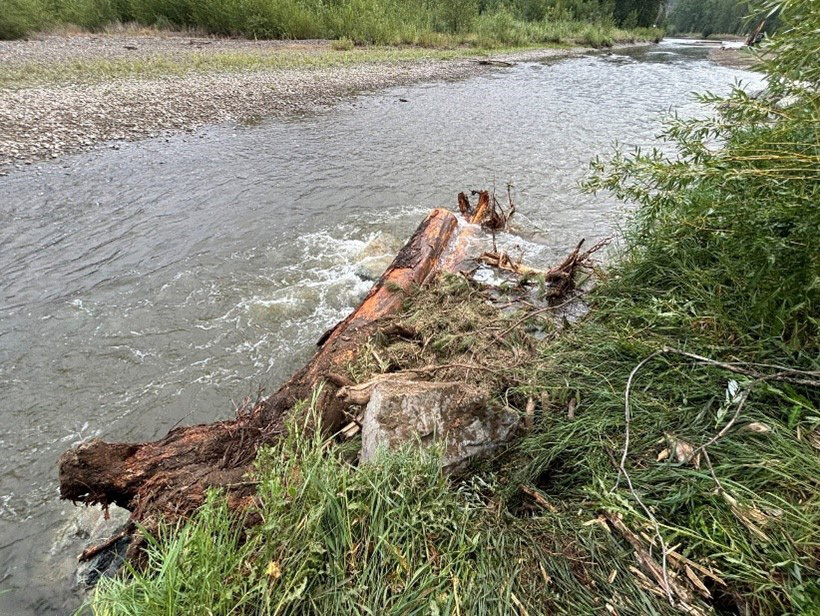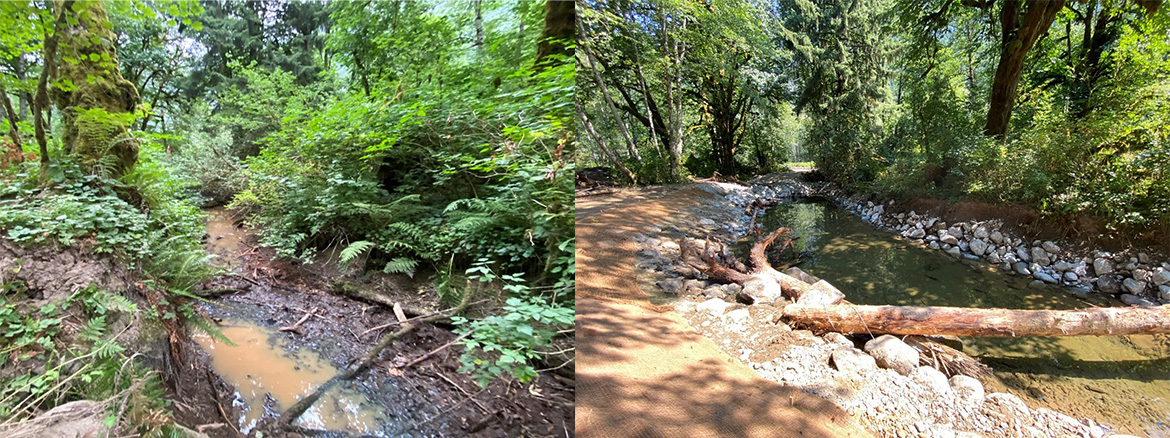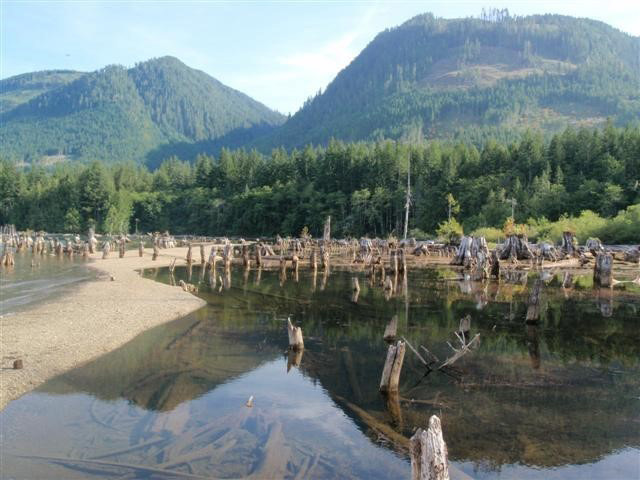Rising to the challenge: Working together to protect Pacific salmon impacted by drought conditions in 2024

Our biologist is setting up small fish traps to catch stranded salmon fry in an area impacted by drought to move them to larger pools of cooler, oxygenated water.
In recent years, extreme environmental conditions have negatively affected Pacific salmon and other aquatic species. Prolonged drought can lower water levels in freshwater systems, increase stream temperatures, and block or impede the passage of salmon to key spawning habitat. Largely made possible through the Pacific Salmon Strategy Initiative (PSSI), we are taking action towards addressing the short- and long- term impacts of drought on fish and fish habitat.
Investments under PSSI have provided us with additional capacity and expertise to support activities related to drought impacts to Pacific salmon and salmon habitat, including response to salmon strandings and sharing information with our partners such as First Nations and Indigenous organizations, the Province of British Columbia, and conservation organizations. We have also developed a coordinated approach to respond faster and more efficiently to drought challenges and other climate disasters impacting fish and fish habitat.
In 2024, we worked with about 60 partners in 75 areas across the Province of British Columbia, including over 30 First Nations and Indigenous organizations, 15 stewardship groups, as well as the provincial BC government to respond to immediate drought-related issues, as well as to create action plans and fund emergency projects. A reporting system for drought-related issues affecting fish and their habitats was established for the public to notify us of salmon impacted by drought by contacting us through the Observe Record Report (ORR) hotline. When we received calls about stranded salmon from areas impacted by drought, we investigated the situation to identify the best course of action to improve salmon survival.
Project profiles highlighted feature collaboration with First Nations and other partners from locations across British Columbia. Activities completed this year addressing drought conditions include increasing water flows to help fish reach spawning areas, monitoring watersheds, buying needed equipment and supporting critical restoration projects. In all cases we respond thoughtfully, and sometimes creatively to ensure both young and adult Pacific salmon have the best chances of survival during periods of warmer and dry climate conditions.
Work undertaken and supported by our Restoration team also promotes the long-term health of salmon populations so that habitats are more resilient moving forward.
Creating cool water pockets in the Nicola River to help salmon thrive in the summer

A large woody debris structure placed in the Nicola River serves as critical fish habitat by providing pockets of cooler waters and attracting insects that are eaten by young salmon.
Salmon need cool water that is rich in oxygen, which becomes an issue when temperatures rise in the summer. Deep pockets of cooler water in rivers help migrating adult salmon and growing juveniles survive when impacted by prolonged heat conditions. This type of cool water habitat in the Nicola River was disturbed due to extreme flooding in the fall of 2021 making it unsuitable for salmon.
In response, Scw’exmx Tribal Council led a collaborative team with the Lower Nicola Indian Band, Nooiatch Indian Band, the Province of B.C. and our Restoration team to build large woody debris structures in the river. This project was funded in part by the British Columbia Salmon Restoration and Innovation Fund and supported by our Habitat Restoration Program under PSSI. These woody debris structures benefit salmon as they provide cover, protection from predators, and attract insects that young salmon feed on. The structures also are expected to work with the river dynamics to form deeper pools in the river bottom that will continue to support adult salmon returning to spawn and juvenile salmon year-round.
Expanding salmon access to spawning habitat on the Indian River in Metro Vancouver

Before and after photos of the new groundwater channel constructed on the Indian River led by səlilwətaɬ (Tsleil-Waututh Nation) and supported by our Restoration team.
For the past two summers, severe drought conditions have been drying up sections of the Indian River, preventing coho, chum, and pink salmon from swimming upstream to more spawning habitat. To address this, səlilwətaɬ (Tsleil-Waututh Nation), with funding from our Aquatic Ecosystems Restoration Fund, collaborated with our Restoration team this summer to design and construct a groundwater channel that expands fish access to further habitat downstream. Crews worked together to dig a shallow channel that expanded and connected low lying wet areas on the floodplain, which helped boost water flow in the area. This new groundwater channel has now added more capacity for juvenile and adult coho, chum, and pink salmon during periods of low water in future years.
Participating in the multi-agency Somass flow committee to protect juvenile and adult salmon on Vancouver Island

The Somass flow committee helps to ensure water levels in sockeye spawning beaches in Great Central Lake and other locations in the Somass Watershed on Vancouver Island are adequate to support Pacific salmon.
During the drought season of 2023, a multi-stakeholder advisory committee was assembled to coordinate water management advice for dam and weir operators in the Somass Watershed on Vancouver Island. Our staff participate in this committee, which provides water management recommendations and advice, such as when to store and release water, by consensus. This work ensures that water levels are adequate in important juvenile sockeye salmon nursery areas and also for adult salmon make it to their spawning grounds, among other objectives.
The advisory committee has now been formalized with a terms of reference and includes representatives from the BC Ministry of Water, Lands, and Resource Stewardship, Hupacasaht First Nation, Tseshaht First Nation, Alberni-Clayoquot Regional District, BC Hydro, Catalyst Paper and several local knowledge stakeholders. This coordination has been critical in protecting vulnerable juvenile and adult salmon in the Somass Watershed.
- Date modified: